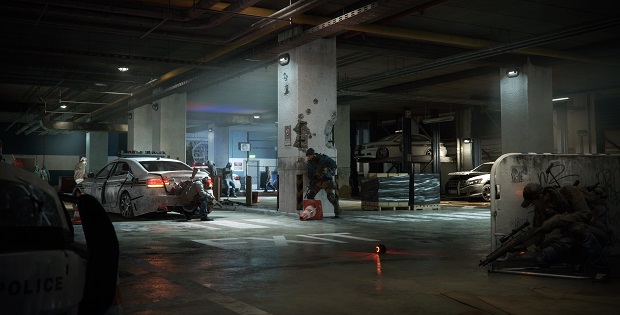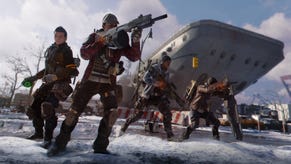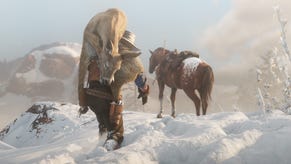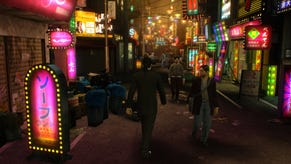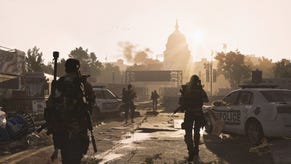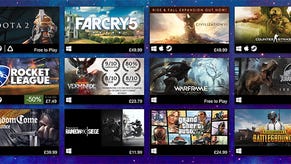"A Matter Of Pride" - Massive Talk PC Development, And The Setting And Structure Of The Division
How to make a Clancy RPG
Last week, I spent a few hours playing The Division [official site] in Malmö, hometown of developers Ubisoft Massive. After the play session, I sat down with Creative Director Magnus Jansén to talk about the game's mechanics and setting, but we also discussed the studio's history as a PC developer. The latter topic came up because The Division has one of the finest PC-specific version I've seen in recent times.
Before jumping into the interview, here's a quick run-down of what you can expect from the PC version of the game. It's unusual to see such a marked difference between PC and console at a preview event, but the version that we four PC-dedicated journalists played was splendid. I usually jump into the menu screens to invert my y-axis and then hop out immediately. The Division has so many options to play with though.
At the base, there are strong keyboard and mouse controls, which make inventory management a drag-and-drop joy in comparison to the controller equivalent. Those go hand in hand with extensive customisation options. Those include a wealth of visual settings (you can turn ambient occlusion off, should you wish) and a fully customisable HUD. Windows and other elements can be resized and shifted around the screen (or screens; up to three are supported as are multiple GPUs) as you desire.
All of that and no framerate locks. Right. On with the interview.
RPS: At what point in development did the game take on its current shape?
Jansén: Because of the enormity of the game, in every single dimension – scope, size, single- and multi-player, an open world – there are many answers to that question. I'll cover the two biggest ones.
The very earliest thing we knew the game would be is “A Clancy RPG”. The Clancy games had always been the more tactical shooter, the thinking man's shooter, when the games started with Red Storm, who are part of the team making this game. Computer role playing games tend to have tactical combat, much more so than shooters do, and to reward thinking more than traditional action games do. So Clancy and RPGs seem like a natural fit.
Then there were challenges of course. But that was at the very beginning, the inception. That's what we set out to do, not too long after we joined Ubisoft, because they had the Tom Clancy umbrella.
The other thing where it clicked was when we were looking into the kind of universe we wanted. What kind of world we wanted. We didn't know whether it would be best to attach it to an existing universe. And when we came up with the idea of a pandemic-stricken that is mid-crisis. A little later than mid-crisis actually – it's the aftermath but it's not the post-apocalypse.
When we came up with that setting, with the lawlessness and everything else that comes with it, we also came up with the embedded unit, the Strategic Homeland Division, which is their proper name. They're trained, they're embedded among the civilian population. They're out on their own, without the support of military infrastructure like air support, guns and gear. They start from nothing almost and live off the land. That fits with how RPGs work, having players start with nothing.
The scavenging, crafting and looting make so much more sense in this setting and in this scenario with these people, rather than in a strict military setting.
RPS: Was it always New York?
Jansén: No. There is never one day when something like that falls into place. New York came quite early. It was after we came up with the pandemic and the fall of society. That's the answer right there, really. Nothing says civilisation as much as New York. That's why when aliens attack they always go for New York. It's the peak of culture.
RPS: It's also very recognisable...
Jansén: Yes, it needs to be iconic. We weren't going to pick...well, I won't say.
RPS: Malmo?
Jansén: (laughs) For sure. New York, though, is one of the pinnacles of where we have come as a species. It's the peak of civilisation this time around so to show how and when society has stumbled, it's perfect. And 'stumbled' is an important word because society hasn't fallen yet. It's your job to make sure that doesn't happen and that everyone isn't left in the mud.
The city that never sleeps is the perfect place to show the impact of this disaster.
RPS: I was reminded of Spec Ops: The Line, which used Dubai for thematic as well as aesthetic reasons. Very different reasons, but a similar desire to have the city form part of the narrative. Dubai represented something new, whereas NYC, even though it's relatively new in the grand scheme of things, has endured.
Jansén: Of course. That's another side of the story. New Yorkers have suffered terrible blows, in just the past fifteen years, with 9/11 and Hurricane Sandy. The story of the New Yorkers, that they're a tough bunch, is something we can draw on as well.
RPS: The Christmas setting struck me as well. It reminded me of Die Hard. I always like it when people say Die Hard is the best Christmas film because it isn't actually a Chritmas film. But it sort of is. Just enough. And The Division, I guess, isn't a Christmas game, but the setting adds something, even if it's just colour and flavour. But why did you pick that time of year?
Jansén: First of all, I completely agree with you. If we're talking about New York as the symbol and pinnacle of society, then what is better to show chaos, evil and mayhem than to take Christmas and ruin it. Nothing is sadder than an unopened Christmas present. So, for sure, that's absolutely one of the extra layers that it adds – a melancholy and sadness, as well as a sense of spectacle. Completely tricked-out department stores abandoned and on fire.
I'm going to be careful about spoilers now but the virus was released on Black Friday and that's definitely a commentary on the hedonism and consumerism. The excess. I can't say too much without giving details away but Christmas is suitable because it's a number of weeks after Black Friday but it's also a perfect setting in other ways, so there's a wonderful serendipity.
RPS: Switching to the actual game mechanics. My favourite thing in what I've played so far is loot collection and salvaging in the Dark Zone. Before we discuss that could you explain what the Dark Zone is and when you decided to include it as an entity in the game?
Jansén: I'll start with how it functions.
The Dark Zone is a large physical space in the centre of our open world map. It's also at the centre of our narrative in some sense. In our narrative, and mechanically, it's a place where The Division agents can choose to prey on each other. All of the rules of engagement are perverted and nobody is checking on them. That's because there are jammers in place so communications are offline.
RPS: The UI glitches out to show that as you enter, right?
Jansén: Exactly. And there are story reasons for that and implications on the narrative as a whole about going rogue, but I'll talk in terms of gameplay mechanics. First of all, there are no loading screens. You can go through a gate or climb over a fence and you're inside, without a loading transition. And once you're in there you can see strangers, other players.
There are also enemies, regular NPCs, and you can take them out and get rewards. But the core of the experience is the ambiguity of interaction with other players. You can walk up to them and use an emote and wave or use proximity VOIP to discuss what to do, maybe even team up to take on enemies, who are pretty tough in the Dark Zone.
But you can also just open fire. And if the other players are carrying things that they've picked up in the Dark Zone, they drop it when you kill them. And you drop your things if you're shot. If somebody then picks it up and steals it, that loot is lost for good. The only way to collect loot there and then recover it is to call in an extraction by helicopter. Then it is decontaminated back at base and placed in your stash there.
RPS: That extraction mechanic is the thing I was going to talk about. It makes you feel cut off and panicked. The further into the Dark Zone you push, the tougher it is to fight back to an extraction zone and when you don't know if the person next to you is going to shoot you in the back as soon as you call the helicopter, it's very tense.
Jansén: We try to keep the population density in the Dark Zone at a level where it's fairly rare to see somebody. When you see someone, it should feel like an event. You're not just tripping over mobs of players all the time. But when you fire up a flare to all in extraction, that can be seen over quite a large radius so you're giving yourself away. NPCs will see it and move toward your position, and friendly or neutral players might well move in to piggyback on your extraction, attaching their loot to the helicopter as well.
And less benign players now know where you are AND that you most likely have something valuable. So you can prepare to defend the area, or hide yourself nearby, or even use an extraction as a decoy while you make your escape.
I'll move on to the second part of your question now. At Massive, we have an incredible server infrastructure, which goes right back to the time of World in Conflict, which was the first RTS that wasn't a peer-to-peer service. IT was true servers, with drop-in and drop-out so if you lost connection, it wasn't the end of the world. That's normal now but we were among the first.
All that expertise is part of our studio, and the power that you get when you invest in all that back-end magic and develop it yourselves rather than relying on third parties is incredible. We put people on those servers to play The Division, very early on, and we realised that we could make this adversarial, PVP-based space. Technically, it was possible, to have it as a seamless part of the wider world. After that realisation, we started seeing that the ambiguity as to player intentions and roles in some PC indie titles was very gripping. We were strengthened in our beliefs, a few years ago, that such a space would work.
Then the extraction mechanic came and then we started to think about griefing. Would people camp around the entrances and how could we deal with that? So we added safe rooms, which are mini safehouses inside the Dark Zone, and then we added a bounty system. When you're rogue, people are informed. And if you go really rogue, then there's a bounty attached to you and that is communicated to other players. They start policing the game.
The inception of the Dark Zone was realising that we could do it technically. There was a lot of work in the match-making and ensuring that level 25 people weren't getting matched with low level players, lots of details to work out, but as soon as we knew that we could technically do it, that was when we started to figure the rest out.
RPS: I like that you can see the contaminated gear on the characters' backs – you know that they have loot as soon as you look at them. That seems to be something that runs through the game. You can visually read the skills that people have equipped and other details just by glancing at the screen. Could you talk about the importance of the UI and those other details?
Jansén: I'll be uncharacteristically bold and proud here! Our UI is pretty frigging awesome. It's a very light, very 3d, very world-space based UI. It's light rather than heavy, it's not static. And it's absolutely vital to our game.
In terms of the world's visuals we're making something super-realistic even though we elaborate on reality. When you do that, and now that rendering is at a point where we're recreading the real world to a tremendous degree, it's important to have a UI that provides information that the real world doesn't provide. We don't have the luxury to do these exaggerated shapes, in the enemies or in the world. We can't show, on another agent, that he has a certain skill by making him bigger or taller or giving in a nine foot sword. So our UI does all of that work.
What I'm really proud of is how we tie that in. At the beginning of development, we were looking at fighter planes and how they display information with minimalist lines. And this is the military, this is how they do things. So what would a future military look like? Well, the infantry now have a lens that displays information, an augmented reality, that shows what you need on demand. That's what fighter planes already have and we're just shifting it to street level. It's legible for the player but also fits into our depiction of this possible future military.
Real life is difficult to read and that's why fighter pilots have what are essentially augmented reality devices to help them to navigate that world. We're bringing in those same tools.
RPS: That conflict between high fidelity realism and the legibility requirements of a game are one of the biggest challenges you must face making a game like this. Your UI reminds me of an elaboration on Dead Space's in-world third-person UI. And on the PC version, you go even further by making the whole thing fully customisable. Elements can be repositioned, resized, completely eliminated. Almost every developer tells us that they care about PC but most don't go this far. How important was all of the customisation in the PC version for you?
Jansén: PC is incredibly important to us. There are plenty of incentives to do a good PC version. Personally it's important – a I play on PC whenever I can and I want the thing they play at home to be the best possible version. That is not to be underestimated as a driving force. Secondly, both of the studios, Massive and Red Storm started out on PC so it's a matter of pride, or heritage and pedigree if you will. We feel kind of ashamed if we don't do the PC version really well. It really is something that we care about.
We're a very technical studio as well. Sweden is a very technical country – we're good at infrastructure and design, and a lot of our staff come from the old demoscene as well. There's a lot of that heritage in the Swedish dev community and that is true here at Massive as well. It comes very natural to us. The engine, Snowdrop, enables the artists to do all of that great UI work and makes it relatively easy to expose all of those options on PC.
RPS: When you start development on a game like this and it starts to take shape, from Tom Clancy RPG to The Division, how do you make sure that all of the features overlap and feed into one another. Is there a point when there can be too much stuff to do – crafting, looting, shooting, and so on.
Jansén: We could talk about that for hours. It's essentially what the job of design is, on a game like this, in one question. It's what the most senior staff – creative directors, game directors, lead designers and so on – spend their time thinking about. What I'll say is that when you get into the incredible scope of a game like this, where you can miss out on huge parts of the game and entire systems even if you've played for hours, the most important thing is that you can get into the game and that it makes sense. Can players successfully resolve combat, using cover and shooting, and can they pick up and equip the tools they need to improve? If so, where do they go from there.
Those initial steps should be intuitive and natural and comfortable. We have the luxury of allowing people to figure out the rest at their own pace. Take the base of operations, which is central to the game in so many ways. We chose to have so many of your skills and the things that you collect and unlock within that base rather than tucked away on menu screens as is often the case in RPGs.
By placing a lot of that development and the things you collect in a physical space within the world, we have players walk through an actual wing in the base and to see how they are expanding and growing. Medical skills are found in the medical wing and you can see the place improving and changing as you unlock those skills.
RPS: The base is a secondary character that you're levelling up and customising.
Jansén: Exactly. By having everything imprinted in the world like that, skills are presented to players in a way that gives them a better understanding of the process of levelling up. If everything is hidden in menus and you don't have to actively gather resources to activate new skills, people are more likely to ignore those skills. They're invested in the base structure and that gives them investment in their character and their skills.
Before we inish, I'd like to mention one other aspect of design. It might seem like a small thing but it's an important part of the way I think about the design of such a huge game.
Many games have loading tips when you fast travel or whatever. We have hundreds of them but we don't throw them at you randomly. Instead, we're checking to see if you've been crafting and if you haven't, we'll point you toward it. You won't have to read about things you've done a thousand times already, we'll direct you toward the things that maybe you haven't discovered or don't fully understand.
Using a similar system, we direct you toward things within the game world, not only during loading – and for loading screens, I include fast travel screens – but when you're actually interacting with the world. So if you're near a ladder and maybe you've never climbed a ladder before, the instructions explaining how do to that will pop up in the UI. Or maybe you have climbed ladders but not for a long time, so we taught you that but you haven't really started to look for ladders in the world or to treat them as pathways, we'll remind you.
RPS: You're always watching us!
Jansén: These are just little checkpoints and toggles. Well, much more complicated than that. The coders will kill me! (laughs) They work very hard to make sure all of this works well. Those pointers are the things we do to make sure people realise the full scope of what's on offer.
RPS: Thanks for your time.

